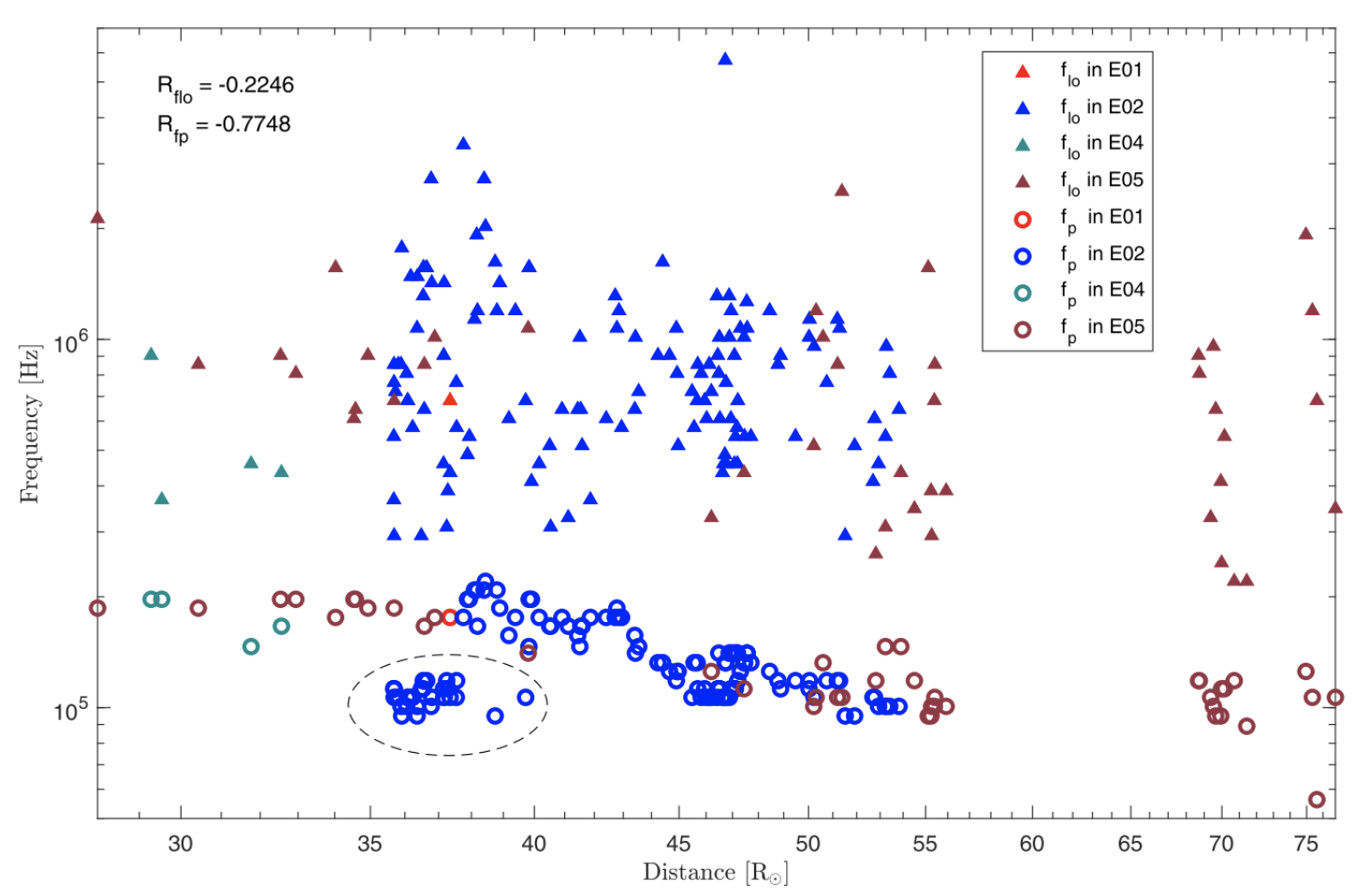Interplanetary (IP) type III radio bursts are deemed to generate in the interplanetary space because of their lower emission frequency ($0.01 – 10$ MHz) in terms of plasma emission. However, using the electron cyclotron maser emission (ECME), Wu et al. (2004) presented that IP type III radio bursts may generate in the low corona. The low frequency cutoffs is an important parameter to research the generation mechanism of type III emission.
Leblanc et al. (1995) and Dulk et al. (1996) investigated the low frequency cutoffs of IP type III bursts observed by Ulysses and Wind spacecraft located in 1–4.3 AU to the Sun. Their results show that: (1) the cutoff frequencies of type III radio bursts $f_{lo}$ are almost all higher than spacecraft’s local plasma frequency $f_p$. (2) The $f_p$ decreases with the distance of spacecraft from the Sun. (3) The $f_{lo}$ mainly ranges from 20 to 300 kHz and it is independent of the location of spacecraft.
NASA’s Parker Solar Probe (PSP) is a spacecraft that was launched on 2018 August 12 and could fly to a closer distance to the Sun than any other previous spacecraft. In this paper, we use the radio data observed by the PSP within 0.25 AU (during PSP’s encounter phases) to study the low frequency cutoffs of the IP type III bursts and preliminarily discuss the possible reasons of the different results from previous studies.
Observation and Analysis
We use the data observed by the Radio Frequency Spectrometer on PSP during the encounter phases of its first five orbits and obtain 176 type III radio bursts and their cutoff frequency $f_{lo}$ and spacecraft’s local plasma frequency $f_p$ by automatic program recognition and manual checking.
The scatter plot of $f_{lo}$ and $f_p$ versus the distance of PSP from the Sun is shown in Figure 1. It is obvious that the distribution of the cutoff frequency is higher than that of the PSP’s local plasma frequency. One can also find that the cutoff frequency is independent of the spacecraft’s position and $f_p$ decreases with the distance if the events with relatively lower $f_p$ in $35-40R_{\odot}$ circled by the black dashed line are excluded, which are associated with a high velocity solar wind stream with low density. These results are consistent with previous studies.
On the other hand, the $f_p$ mainly ranges from 50 to 250 kHz, which is much higher than that observed by Ulysses and Wind (3-50 kHz). It is easy to understand because PSP is much closer to the Sun than Ulysses and Wind, and its ambient electron density is higher. However, there is a significant difference between the distributions of $f_{lo}$ observed by PSP (200 kHz−1.6 MHz) in this study and in previous work based on Ulysses and Wind (20-300 kHz) by Leblanc et al. (1995) and Dulk et al. (1996). We propose three possible reasons:
 Figure 1 – Measurements of characteristic frequencies ($f_{lo}$ and $f_p$) of 176 type III events vs. the corresponding distances of PSP from the Sun. The solid triangle and the hollow circle indicate $f_{lo}$ and $f_p$, respectively. Different colors of marks denote different encounter phases of PSP. Some events with relatively lower $f_p$ in 35-40 $R_{\odot}$ during E02 are circled by the black dashed line. The correlation coefficient $R_{flo} = -0.2246$ implies that $f_{lo}$ is independent of the PSP’s location. And $R_{fp} = -0.7748$ implies there is apparent dependency between $f_p$ and distance of PSP from the Sun.
Figure 1 – Measurements of characteristic frequencies ($f_{lo}$ and $f_p$) of 176 type III events vs. the corresponding distances of PSP from the Sun. The solid triangle and the hollow circle indicate $f_{lo}$ and $f_p$, respectively. Different colors of marks denote different encounter phases of PSP. Some events with relatively lower $f_p$ in 35-40 $R_{\odot}$ during E02 are circled by the black dashed line. The correlation coefficient $R_{flo} = -0.2246$ implies that $f_{lo}$ is independent of the PSP’s location. And $R_{fp} = -0.7748$ implies there is apparent dependency between $f_p$ and distance of PSP from the Sun.
(1) Solar activity intensity in different observation periods is different and it can influence the magnetic energy release and the propagation distance of electron beams in active regions. Therefore, solar activity intensity may affect the cutoff frequency of type III radio bursts.
(2) The criteria of event selection may also play an important role. We consider many events with shorter duration and weaker intensity than previous studies. These events may have much higher $f_{lo}$.
(3) The spacecraft located further from the Sun may be hard to receive the emission of weak bursts with higher cutoff frequencies due to the radiation attenuation effect, and thus the statistics of $f_{lo}$ observed especially by Ulysses only covered the stronger events with lower $f_{lo}$.
The statistics of multipoint observation by spacecraft like PSP, Wind, or Solar Orbiter may provide more details about the influence factors of the low frequency cutoffs of type III bursts in the future.
Based on a recent paper Bing Ma et al 2021 ApJL 913 L1 DOI: https://doi.org/10.3847/2041-8213/abfb77
References
Wu, C. S., Reiner, M. J., Yoon, P. H., Zheng, H. N., & Wang, S. 2004, ApJ, 605, 503
Leblanc, Y., Dulk, G. A., & Hoang, S. 1995, GeoRL, 22, 3429
Dulk, G. A., Leblanc, Y., Bougeret, J.-L., & Hoang, S. 1996, GeoRL, 23, 1203
